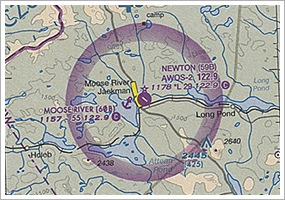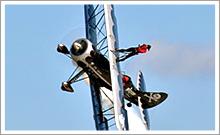The Sept. 24, 2010, issue of 'AOPA ePilot: Flight Training Edition' newsletter
| ||||
| | FT News | INSIDE AOPA | TRAINING PRODUCTS | FINAL EXAM | |||
TRAINING TIPsRemote airports The Sept. 17 “ Training Tip: Destination weather” urged pilots to cast a wide weather net when flying to a destination that has no on-field observations. Related considerations when flying to out-of-the-way places are limited communications and aircraft services. Over uniform or sparsely populated terrain there may be few good visual checkpoints for navigation. An example of a remote airfield is Newton Field, an unattended airport in mountainous Jackman, Maine. According to its listing in AOPA Airports, the rotating beacon is out of service and runway markings are faded. Comments from a pilot who used the airport provided some nice-to-know details: “Nice little strip with automated self-serve fuel, bathroom and phone to call FSS (no cell service around there). Tie-down rings are there, but bring your own ropes and chocks.” That’s the situation on the ground. Airborne radio communications may be limited in remote areas too. So it’s important to check for any remote communications outlets during flight planning. “When you find yourself in the middle of nowhere and in need of some current weather information, you can look at your chart and find an RCO, or remote communications outlet. These outlets serve flight service stations and allow you to contact a flight service specialist by relaying your signal through the outlet when distance or obstacles would make direct radio communication impossible,” Elizabeth Tennyson explained in the April 2001 Flight Training’s “ Aviation Speak.” When airports are few and far between, combine methods of VFR navigation such as pilotage and radio navigation to make it less likely that you’ll miss a visual checkpoint or have trouble spotting the airport. Such a flight makes filing and activating a VFR flight plan a great idea, too. Why? “Filing a flight plan is not required by regulations; however, it is a good operating practice, since the information contained in the flight plan can be used in search and rescue in the event of an emergency,” explains Chapter 15 of the Pilot’s Handbook of Aeronautical Knowledge. Test your safety sensibilities against this AOPA Air Safety Foundation safety quiz on emergency procedures—especially Question Five, which considers a forced landing in a remote area. Answering it correctly is a great indication that you’re good to go. YOUR PARTNER IN TRAININGCrosswind technique, using the trim wheel, go-arounds. Flight Training magazine’s redesigned Technique section brings you essential skills broken down to their basic elements, plus a video that puts it all together. Review past articles in the Flight Training magazine archives.
Did you know that student pilots who join AOPA are three times more likely to complete their flight training? Membership includes unlimited access to aviation information by phone (800/USA-AOPA, weekdays from 8:30 a.m. to 6 p.m. Eastern time) or from AOPA Flight Training Online or AOPA Online. If you're not already a member, join today and get the pilot's edge. Login information is available online. FLIGHT TRAINING NEWSAOPA Aviation Summit a launching pad for studentsWith more than 65 hours of educational seminars, a pilot’s shopping paradise, the biggest names in aviation, and almost 100 aircraft on display, AOPA Aviation Summit 2010 is the place for student pilots. Held this year in Long Beach, Calif., Nov. 11 through 13, Summit is the association’s yearly trade show that caters solely to pilots. Students and flight instructors will find a huge amount of helpful and fun resources. What’s more, Flight Training Deputy Editor Ian J. Twombly will hold a flight instructor roundtable and a student roundtable on Nov. 13—your chance to network or just come to talk about any topic you like. For more information on Summit, see the website. Remember to ‘line up and wait’Heads up! Put a reminder on your kneeboard: Effective Sept. 30, “line up and wait” replaces “taxi into position and hold.” What do these new words mean? The same thing—you may taxi onto the runway and wait for a takeoff clearance. This change in ATC terminology brings the United States in line with standard International Civil Aviation Organization phraseology. Learn more >> PAIFA acquires Aeroservice Aviation CenterPan Am International Flight Academy (PAIFA) has acquired Aeroservice Aviation Center, including all of its training and simulator assets. Aeroservice’s Miami, Fla., training center will become PAIFA’s seventh facility and will operate under PAIFA’s Part 142 certificate, the company said. For more information, see the website. Flight school briefsBob Miller Flight Training Inc., based in Buffalo, N.Y., has opened a satellite flight school at the Genesee County Airport in Batavia, N.Y. The new location offers training in a Garmin G1000-equipped Cessna 172SP as well as a light sport aircraft. Inside AOPATest your regulatory knowledgeNobody starts flight training with romantic visions of long study sessions and dense government publications. Still, there’s a good bit of “book learning” to be done for the checkride, and getting up to speed on the general operating rules in Part 91 of the federal aviation regulations is part of it. Do you know when you’re required to use supplemental oxygen? Or how fast you can fly in Class C airspace? Challenge yourself with the AOPA Air Safety Foundation’s latest safety quiz. AOPA Foundation calendar promotes GAProtect your freedom to fly all year long with the new 2010-2011 AOPA Foundation calendar, where each month you’ll see beautiful photographs, as well as valuable safety tips to remind you of the life-saving tools you help to provide. These tools that keep pilots safe are just one example of the many ways the foundation is able to protect your freedom. Your support will help ensure that the foundation has the resources needed to continue to fund air safety courses, quizzes, and Webinars, as well as provide additional support for protecting airports, building the pilot population, and improving general aviation’s image. To receive your calendar please make a donation. AOPA Airports book: Limited quantity, limited timeAOPA has shifted financial resources from the print version of AOPA Airports to enhance the association’s online and mobile versions in response to the preferences expressed by the majority of members. However, AOPA knows that the print version still has high value to some members who have relied on it as a handy reference in the cockpit. The new 2011-2012 AOPA Airports is your perfect flight-planning companion. Carry it in your flight bag and take it with you wherever you fly. You'll have the information you need—at your fingertips—from in-depth diagrams of runways, to restaurant and lodging options and more. A limited number of AOPA Airports will be printed in book format. To order yours for delivery in late December 2010, visit the website. TRAINING PRODUCTSSmall headset/accessory bag from Pilotmall.comFlight bags are no longer one-size-fits-all. Depending on your needs, you can find nearly every size, shape, color, and fabric. And, if you’re looking for a smaller bag to tote a headset or two and a few accessories, Pilotmall.com has a well-constructed, economical entry ($24.99) for you to consider. The bag measures just 11.5 inches tall by 10 inches wide by 9 inches deep, comes with a detachable shoulder strap, and is made of 840 denier nylon. Note that this bag was to be included in the August 2010 Flight Training Gear Guide but missed the cut only because of a photo deadline. Order it online.
Note: Products listed have not been evaluated by ePilot editors unless otherwise noted. AOPA assumes no responsibility for products or services listed or for claims or actions by manufacturers or vendors. FINAL EXAMQuestion: When can I log night time for the purposes of meeting the requirements for getting a private pilot certificate?
Answer: Under 14 CFR 1.1, "night" is defined as the time between the end of evening civil twilight and the beginning of morning civil twilight, as published in the American Air Almanac, converted to local time. There is a calculator that can help you determine when civil twilight is, based on the date and your location. For more information on night regulations, read this article from AOPA Pilot.
Got a question for our technical services staff? E-mail [email protected] or call the Pilot Information Center, 800/872-2672. Don’t forget the online archive of “Final Exam” questions and answers, searchable by keyword or topic. what’s new onlineAirline flight planningWho does the flight planning for a commercial airline flight? Surprisingly, it’s not the captain or even the first officer. The dispatcher is the one who makes the route decisions. Read more from Chip Wright in the Flight Training blog. Picture Perfect
AVIATION EVENTS & WEATHER To include an event or to search all events in the calendar, visit AOPA Online. For airport details, including FBO fuel prices, see AOPA Airports. Flight Instructor Refresher ClinicsThe next AOPA Air Safety Foundation Flight Instructor Refresher Clinics are scheduled in Windsor, Conn., and Columbia, S.C., Oct. 2 and 3; Wichita, Kan., and Nashville, Tenn., Oct. 9 and 10; Indianapolis, Ind., and Corpus Christi, Texas, Oct. 16 and 17; San Jose, Calif., and Fort Lauderdale, Fla., Oct. 23 and 24. For a complete schedule, see AOPA Online.
Can’t make it in person? Sign up for the CFI Refresher Online. AOPA Air Safety Foundation Safety SeminarsAOPA Air Safety Foundation Safety Seminars are scheduled in Mesa, Ariz., St. Louis, Mo., Pittsburgh, Pa., and Fort Worth, Texas, Sept. 27; Tucson, Ariz., Springfield, Mo., Summerdale, Pa., and Houston, Texas, Sept. 28; Albuquerque, N.M., Allentown, Pa., and San Antonio, Texas, Sept. 29; King of Prussia, Pa., and Austin, Texas, Sept. 30; Bolingbrook, Ill., Oct. 4; Northbrook, Ill., Oct. 5; Rockford, Ill., Oct. 6; Poughkeepsie, N.Y., and Madison, Wis., Oct. 11; Colorado Springs, Colo., Cohoes, N.Y., and Milwaukee, Wis., Oct. 12; Northglenn, Colo., Tompkinsville, Ky., Gaithersburg, Md., and Manitowoc, Wis., Oct. 13. Topics vary—for details and a complete schedule, see AOPA Online. | Advertisers Got news? Contact ePilot. Having difficulty using this service? Visit the ePilot Frequently Asked Questions now at AOPA Online or write to [email protected]. |
| This issue of ePilot was created for &fname; &lname; at &*TO; Member Tools : Send feedback | Update member profile | Change email address | Unsubscribe | ePilot Archive Editorial Team: ePilot Flight Training Editor : Jill W. Tallman | ePilot Editor: Sarah Brown | Contributor: Alton K. Marsh |





